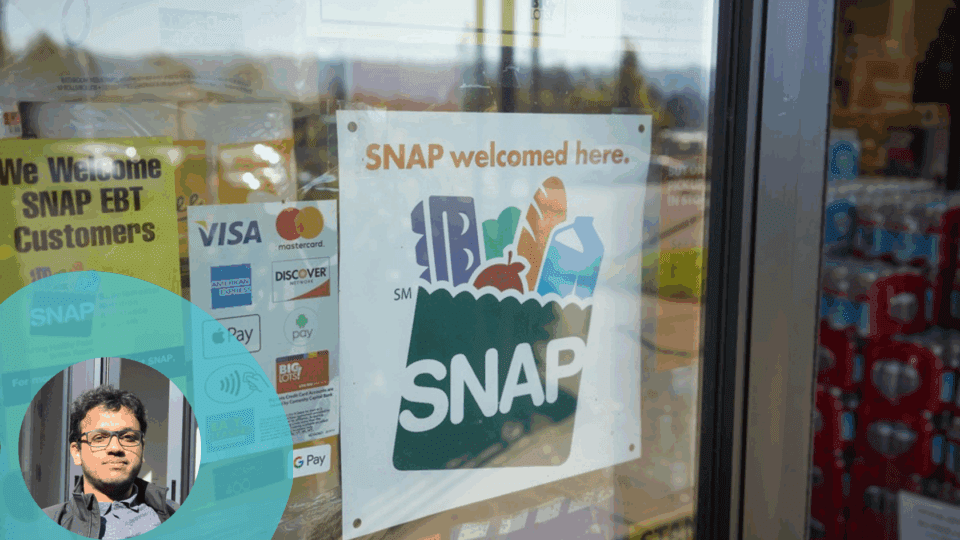March 2020 brought an unnerving tide of news reports, a growing sense of unease, and the undeniable arrival of the COVID-19 pandemic. As cities locked down and uncertainty swept the nation, my familiar world of software development felt increasingly distant from the stark realities unfolding outside. Millions found themselves confined, facing anxieties not just about a novel virus but about basic survival.
For a particularly vulnerable group – recipients of the Supplemental Nutrition Assistance Program (SNAP), commonly known as EBT users – the pandemic presented an agonizing dilemma. Primarily reliant on in-person grocery shopping to use their benefits, they now faced an impossible choice: risk exposure to a deadly virus in crowded stores or struggle to access essential food for their families. The systems designed for one reality were instantly fractured by the demands of another, exposing a critical gap in the nation’s food access infrastructure.
The scale of this gap quickly became terrifyingly clear. What few outside the sphere of government benefits and payment processing realized was the extremely limited scope of online EBT acceptance pre-pandemic. It wasn’t merely uncommon; it was practically non-existent, confined to a small, obscure USDA pilot program operating in just a handful of zip codes. The digital rails needed to carry these essential benefits into the online grocery ecosystem simply had not been laid on any meaningful scale.
Against this backdrop, my team and I received a mandate that felt staggering in its ambition and urgency: build a nationwide EBT acceptance system for Instacart, and do it in four months. A project that, under normal circumstances, would represent a multi-year undertaking involving intricate technical development, complex regulatory navigation and extensive partner integration was now an emergency response measure. The timeline wasn’t just accelerated; it was compressed almost beyond recognition.
This wasn’t merely a technical challenge; it was a race against a rapidly escalating human crisis. As lockdowns continued and economic disruption spread, food insecurity surged across America. The code we were tasked with writing, the systems we needed to architect, represented more than just a new feature; it was a potential lifeline for millions struggling to feed their families safely.
The months that followed were a crucible. Our team worked relentlessly, often around the clock, navigating the added complexities of remote collaboration during a global health crisis. The task demanded intense coordination not only internally but with a vast network of external partners: government agencies at both federal and state levels, payment processors grappling with new requirements and grocery retailers, many of which had never seriously considered integrating EBT payments into their digital operations.
The regulatory landscape alone was a formidable obstacle. SNAP/EBT systems were fundamentally designed for the physical world of swipe cards and PIN pads, not the fluid environment of ecommerce. Each state had its own distinct implementation requirements and approval processes, creating a complex patchwork of rules that had to be meticulously understood and integrated. Navigating this labyrinthine world of government benefit regulations while simultaneously building a secure and user-friendly online system became my all-consuming focus.
Amidst the blur of development sprints and regulatory meetings, one moment stands out: the night we pushed our very first EBT transaction to production. I vividly recall the anticipation and pressure culminating in that single order, placed by a family in South Carolina. It represented far more than a successful deployment; it symbolized months of frantic effort, countless hurdles overcome and technical innovation born from sheer necessity. It was a beacon of hope, proof that the impossible might just be achievable.
Following that initial breakthrough, the pace did not slacken. As the pandemic continued its relentless march through 2020 and 2021, we rapidly scaled the system. What began as a pilot expanded to hundreds of retailers across dozens of states by early 2022. Systems that typically required years of careful planning, development, testing and deployment were being built and rolled out in a matter of weeks, driven by the persistent, urgent need.
Amidst the whirlwind of building and scaling, a routine analysis of user data delivered a jolt. Late one night, while examining checkout flows, I noticed a troubling pattern: a significant number of visitors originating from lower-income zip codes were adding groceries to their carts, proceeding to checkout, and then abruptly abandoning the process. It wasn’t just random attrition; it was a distinct signal concentrated in areas where EBT usage was likely higher.
This data point sparked a critical hypothesis in my mind: these weren’t users simply changing their minds. They were likely EBT recipients, navigating the online store, selecting their needed groceries, only to discover at the final, crucial step that their primary means of payment wasn’t accepted online. The data wasn’t just indicating friction; it was revealing a moment of profound disappointment and likely frustration for users who had invested time and hope in the process.
This realization served as a powerful wake-up call for me and the team. It underscored that simply enabling EBT transactions wasn’t sufficient. The system needed to be designed with a deeper understanding of the EBT user’s journey, anticipating their needs and potential pain points before they hit a dead end.
Code as Compassion: Engineering the Foundation
The insight gleaned from the cart abandonment data became a driving force behind the next phase of development. It wasn’t enough to simply process EBT; the system needed to guide and support users from the moment they arrived. This led me back into the complexities of benefit regulations and spurred the development of foundational features designed explicitly to pre-empt the frustration revealed by the data.
First came an address-based detection system I built. By leveraging geographic data, the platform could intelligently suggest EBT payment options upfront to users in areas with high benefit usage. This simple, proactive step aimed to prevent the late-stage disappointment, informing users early in their shopping journey that their benefits could potentially be used. Crucially, this feature included user controls, allowing individuals to manage this suggestion based on their preference.
Next, our team tackled the enormous complexity of SNAP eligibility rules. We engineered an eligibility engine capable of evaluating Instacart’s entire, vast catalog of items in real time. This system determined precisely which products qualified for purchase with EBT funds, providing clarity to users as they shopped and preventing confusion at checkout.
The payment flow itself presented the most significant technical hurdle. EBT users often need to pay for groceries (EBT-eligible) and other items (like fees or non-food essentials) in a single order. I architected a sophisticated split-tender functionality. This system could seamlessly process multiple payment methods within one transaction, automatically applying EBT funds to eligible items first and smoothly transitioning any remaining balance to a secondary payment method like a credit or debit card, all without causing user confusion. These technical solutions, born from that “wake-up call” data, were fundamentally about removing barriers and creating a more intuitive, supportive path for EBT users.
Beyond Transactions: Engineering for Dignity
As the system evolved, testing with actual EBT recipients provided another layer of crucial understanding. Functionality was vital, but the experience of using the system carried its own weight. Feedback revealed that some users felt a sense of stigma or discomfort when using their benefits, even online. This feedback sparked a conscious effort within our team to embed privacy and dignity directly into the platform’s design.
Recognizing the potential for unconscious bias, we built privacy protections into the shopper application used by fulfillment staff. The system was designed to conceal the customer’s specific payment method details from the Instacart shopper picking and packing the order. This measure aimed to ensure that interactions, especially around item replacements or service issues, were handled without prejudice based on payment type.
For customers choosing grocery pickup, another subtle but significant feature was implemented. I modified label-generation algorithms to omit any identifiers that might indicate EBT payment on the order labels. This allowed customers to collect their groceries discreetly, preserving their privacy and dignity during the handover process.
Our commitment to user well-being extended to more proactive, data-driven features. Analyzing millions of transactions revealed distinct, state-specific patterns of when EBT benefits were disbursed. This led to the development of what I considered a landmark achievement: a benefits cycle optimization engine. This system allowed us to intelligently time promotions and adjust inventory predictions, ensuring greater product availability and potentially more impactful savings for customers precisely when they received their monthly benefits.
Furthermore, we built custom recommendation engines. These suggested affordable, nutritious alternatives if a user’s chosen item was out of stock, prioritizing EBT-eligible options when appropriate. Building on this, intelligent bundling logic suggested complementary non-food essentials (like cleaning supplies or personal care items) alongside EBT-eligible groceries, sometimes paired with strategic discounts to help customers maximize their overall budget.
These features represented a shift beyond merely facilitating transactions to actively supporting the user’s needs, grounded in the principle that technology should not only function efficiently but also operate with respect and consideration for the user’s circumstances.
The Ripple Effect: Measuring What Matters
The impact of this concerted effort, born in crisis and refined through empathy, was profound. Within 18 months of our first transaction, Instacart’s EBT systems were processing orders across more than 44 states and integrated with hundreds of retailers. The business metrics validated our approach: EBT customers demonstrated higher retention rates than traditional customers, indicating the service was meeting a critical, ongoing need and fostering loyalty. Furthermore, this customer segment contributed significantly to the business, accounting for approximately 10% of company revenue.
This data powerfully illustrated that designing for inclusion and serving vulnerable populations was not merely an act of corporate social responsibility, but a strategically sound decision yielding tangible business value. The high retention rates suggested that by meeting a fundamental need previously unaddressed in the digital space, we had cultivated a loyal and appreciative customer base. The perceived dichotomy between “doing good” and “doing well” dissolved; the social impact and business success were demonstrably intertwined.
Yet the numbers told only part of the story. The true measure of success, for me and the team, often arrived not in spreadsheets, but in emails. Messages from customers – a grandmother in rural Wyoming expressing gratitude for groceries delivered during a blizzard, a disabled veteran appreciating the ability to shop with dignity without facing physical store limitations – these were the testaments that resonated most deeply. They painted a vivid picture of the real-world difference our system was making in people’s lives.
The intense journey of building Instacart’s EBT system under extreme pressure yielded invaluable lessons, extending far beyond the specific context of online grocery or benefit payments.
Practical Tips
- See the need before it hits a wall: Use geographic and user data proactively to anticipate needs and suggest relevant options early in the user journey.
- Align with users’ realities: Understand external rhythms (like benefit disbursement) that shape user behavior and design systems that actively support them.
- Curate for accessibility: Leverage digital flexibility to create tailored experiences (like EBT-focused aisles) addressing specific user needs.
- Design for dignity, not just function: Recognize and actively mitigate potential social stigma through thoughtful design, ensuring a respectful and safe experience.
- Make complexity invisible: Engineer seamless solutions for complex requirements (like multi-tender payments) to minimize user burden and confusion.
- Amplify impact holistically: Think beyond the core transaction; use recommendations and strategic offers to help users maximize resources.
- Ensure equitable access: Prioritize performance on diverse devices and network conditions, recognizing reliance on older/less powerful tech.
- Protect the vulnerable: Implement specialized, compliant security and fraud prevention tailored to unique risks, balancing protection with usability, like building timed sessions that automatically log out on public computers.
Mridul Singhai is a software engineer with over 10 years of experience who built Instacart‘s first-of-its-kind online EBT system between 2020 and 2024. He worked directly with USDA on policy and design standards. Currently a software engineer at X, Singhai brings strong technical expertise and strategic insights to create socially responsible technologies that deliver business value.




